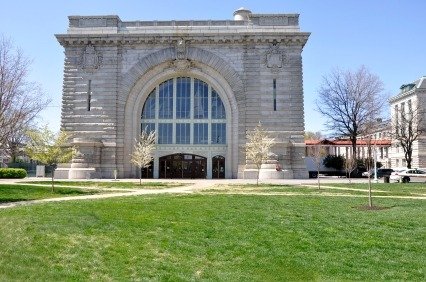Ward Hall, located on the U.S. Naval Academy (USNA) in Annapolis, MD, needed to renovate their existing data center. This was driven by the age of the building in which the data center was housed and increasing demands on the IT department to support the growing technology requirements of the Academy’s student body and faculty members. As a leader in their field, the Naval Academy also wanted to invest in a new energy efficient and reliable data center facility that would provide a platform for computing over the next 20 years and allow them to reduce their energy consumption by up to 40%.
Implementation
In response to the needs of the USNA, GMS designed a solution that incorporated energy efficient cooling solutions in the data center—utilizing high density InRow cooling units from APC, along with a modular chiller from Tandem which helped to provide the N+1 redundancy necessary for this mission critical implementation. A unique and innovative geothermal solution was designed to generate the chilled water necessary to cool this mission-critical data center 24/7/365.
The initial design process thoroughly discussed the needs of the USNA alongside the best options for making the chilled water to satisfy the requirements of a 24/7/365 mission critical data center. A number of solutions were on the table, but the USNA was determined to deliver a cutting edge solution that incorporated all of the desired energy efficiencies and up-to-date cooling technologies available. The project was ultimately broken down into two parts, the implementation of the geothermal chilled
water loop and the chiller and cooling equipment in the data center itself.
Geothermal
One of the key early challenges was to find a company with the necessary experience to help GMS design and build a geothermal solution that could provide year round chilled water in Maryland’s changeable climate. Most geothermal implementations are not running 24/7/365 and have an opportunity to “cool the field down” when not in use. With a mission critical data center however, the chilled water needs to be constantly generated. The designers needed to ensure that some form of heat rejection was built into the plan so that the geothermal well field, comprising 75 wells at a depth of 450 ft each, didn’t overheat. This initial concern was overcome when GMS was able to use the heat generated by the field to provide domestic hot water and heating to the building housing the data center and additional structures nearby.
Once the design phase was completed, work began on drilling the well field which had to be accomplished during the Maryland winter months—with occasional stops for snow and ice. Each of the 75 wells needed a return and supply pipe which ran the length of the 450ft well and then connected into the horizontal pipe lines buried in trenches 48” below grade. These pipes then led into the modular chiller located in the crawl space below the data center. In all, the well field comprises over 30,000 feet of piping.
Data Center Cooling Equipment
Once the geothermal field was finished, the process of building the mechanical infrastructure within the data center itself was started. The USNA had already identified their requirement for an InRow cooling solution to ensure adequate and energy efficient cooling for their IT equipment. The key decision within the data center was the choice of chiller which needed to be modular to meet the N+1 requirements of the USNA, but also needed to fit into the relatively small crawl space below the data center. After consultation with a number of manufacturers, a modular chiller was chosen that met all of the mechanical and customer requirements. The installation of the chiller, the InRow units and controls for remote monitoring was relatively painless thanks to the experience and expertise of the GMS field team who have worked on many similar projects. This process took the project through the spring months and resulted in a safe, efficient and reliable cooling solution for the USNA data center.
Conclusion
The USNA now has a cutting edge cooling infrastructure that will take their data center forward for the next 20 years. It will provide reliable chilled water year round from the geothermal ground loop which has a lifetime expectancy of 50 years. The N+1 redundancy built into the solution will ensure that should any part of the solution fail, cooling will continue to be funneled into the data center, so the IT department can continue to support the growing needs of their users for many years to come.


